A laid-back chat with the celebrated actor about his new role opposite Kevin Costner in Netflix’s The Highwaymen.
Who WAS Maney Gault? Hint: He bore no relation to John Galt in Ayn Rand’s Atlas Shrugged.
Better hint: He bore arms and rode shotgun with Texas Ranger legend Frank Hamer, tracking down the most infamous, chronically romanticized outlaw couple of the 1930s.
Even better hint: He bore a workable resemblance to his portrayer in the Netflix film The Highwaymen (March 29) — an actor who commands a tad more name recognition than Maney Gault these days and could honestly do without the whole grandiose introduction here. Just ask him.
“I wasn’t all that confident in this role,” Woody Harrelson volunteers in typical plain-talk understatement, when pressed on his latest of so many acclaimed performances covering a gamut of characters and genres over the last three decades since his breakout days of Cheers. “But then I saw the finished product — and I really like the movie. It’s just such a big story in our history. I mean, everybody kinda knows where it’s going, but it’s quite the amazing journey.”
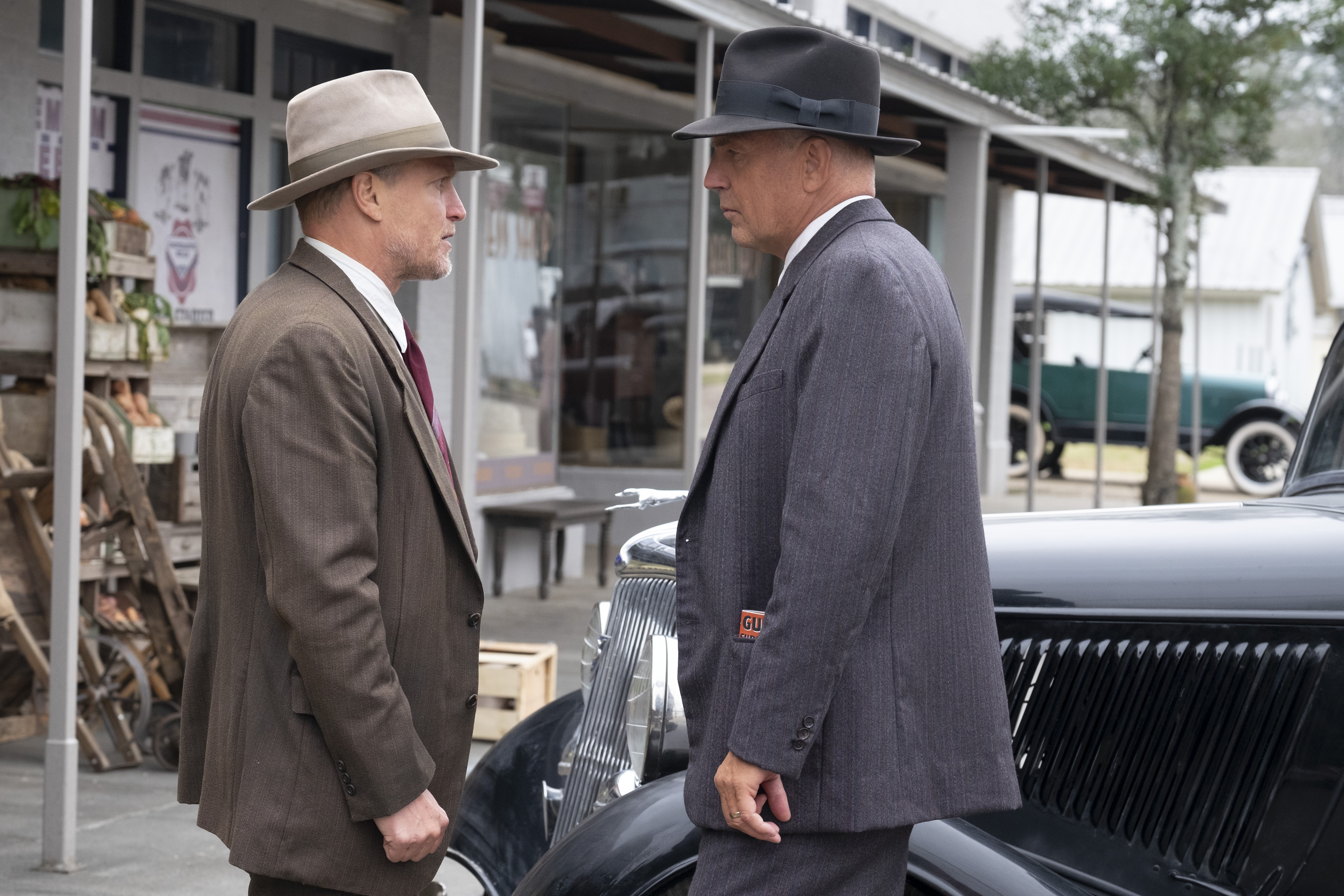
Woody Harrelson and Kevin Costner are on the hunt for notorious criminals in Netflix’s The Highwaymen. Photography: © 2019 Netflix/All Rights Reserve
The latest stop of his own amazing journey, The Highwaymen teams up the 57-year-old actor with Kevin Costner, as a pair of veteran Texas law enforcers commissioned to track down the elusive Bonnie Parker and Clyde Barrow and their bank-robbing, cop-shooting, Texas-to-Ohio havoc-wreaking Barrow Gang.
“Seeing it from the lawman’s perspective was what really grabbed me from the start with this project,” notes Harrelson, whose recent run of nuanced cop roles garnered an Oscar nomination for his work in Three Billboards Outside Ebbing, Missouri and devoted fans for HBO’s True Detective series. “Y’know, no one ever really thinks about that with Bonnie and Clyde. What it was like from the other side.”
Talking with Woody Harrelson on a Tuesday morning from the other side of the Pacific Ocean, it can be a trip just getting your head around the fact that the easygoing dude casually chatting over the phone from his lofty Maui, Hawaii, home about things like under-appreciated 1930s law enforcement, his favorite Old West television show, and why he may some day need to move back to Texas is the same voice behind that other Woody from eight seasons of inspired sitcom work. And Mickey Knox from Natural Born Killers. And Kingpin’s Roy Munson. Larry Flynt, LBJ, The Messenger’s Capt. Tony Stone, Haymitch Abernathy of The Hunger Games, Solo: A Star Wars Story’s Tobias Beckett, Billy Hoyle in White Men Can’t Jump, The Cowboy Way’s Pepper Lewis, and so many others.
An even bigger trip: when he confesses that he’s taking this call in bed after pulling an all-nighter with local pal Willie Nelson.
Anyway, back to Maney Gault. So who was he again?
In this actor’s formidable hands, the name should start ringing a bell.
Cowboys & Indians: The Highwaymen isn’t the first narrativized retelling of Bonnie and Clyde. But it takes a novel approach and has our early vote for the most grounded and historically attentive take on the story yet — plus it’s a great ride. What attracted you to this project?
Woody Harrelson: Well, thanks, Jordan. I’m glad you liked the film. And, by the way, my brother’s name is Jordan too.
C&I: Nice. So what does that make us — like second cousins?
Harrelson: [Momentary pause. Then the unmistakable, endearing “heh-heh-heh-heh” Woody laugh—still going strong so many years after those 200 fabled Cheers episodes.] Yeah. I guess so ... [Back to The Highwaymen] Well, I was really wanting to work with John Lee Hancock. I think he’s just a phenomenal director. I’d read the script — years ago actually — and just thought it was amazing. At some point, supposedly, [Paul] Newman and [Robert] Redford were talking about doing it, so that kind of indicates the quality of the work and the project. Then they brought Kev [Kevin Costner] on, which is just some wonderful casting right there ... and what more can you really ask for?
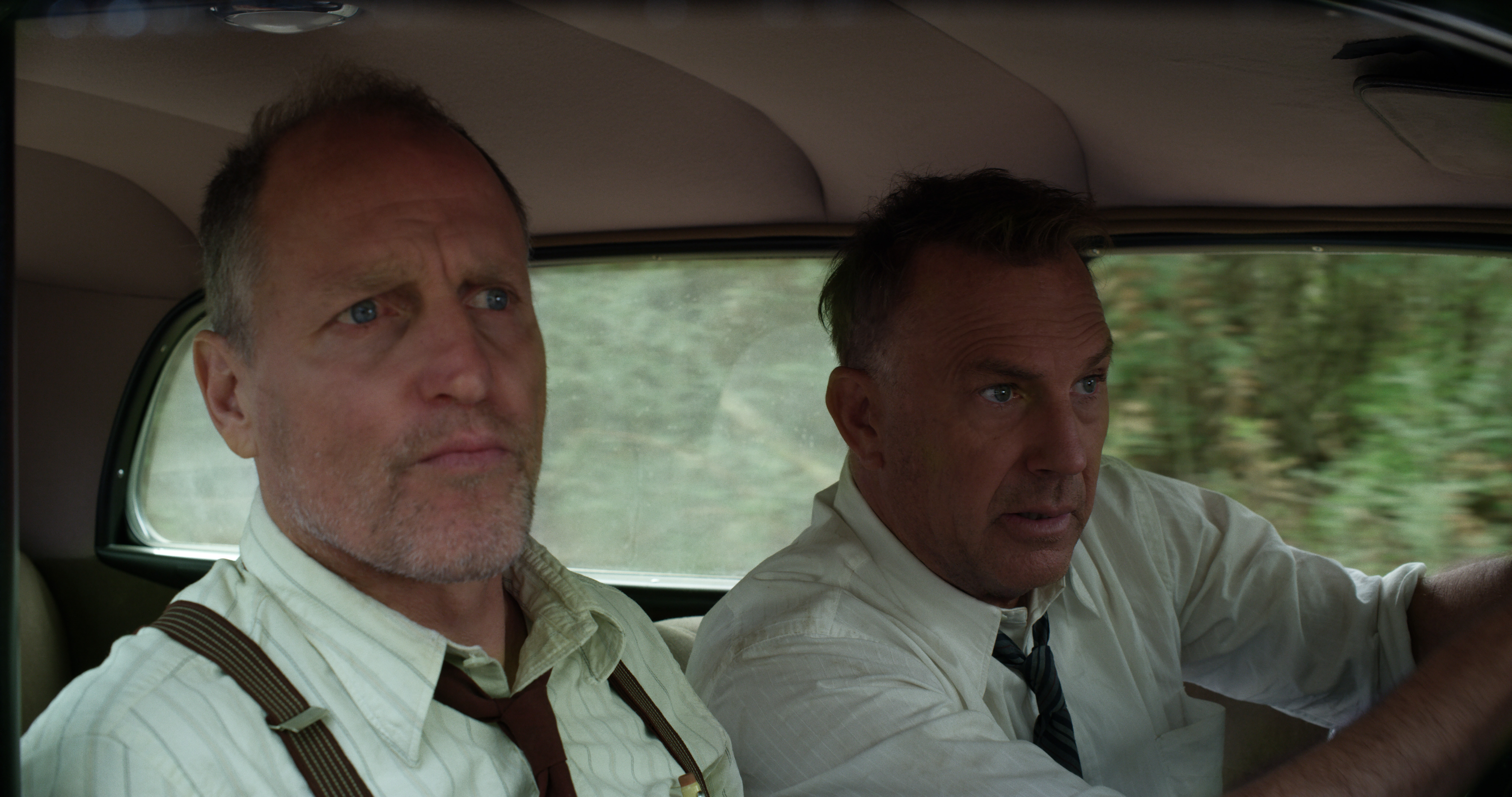
Photography: © 2019 Netflix/All Rights Reserved
C&I: The movie follows the story from the lawmen’s side: specifically, the two former Texas Rangers, Frank Hamer and Maney Gault, assigned the grueling task of finding and stopping the most notorious criminal couple in American history. It also veers away from all the sensationalism, romanticism, and outright fabrication that Bonnie Parker and Clyde Barrow have attracted over the years, from the 1930s on. Do you think we got it right this time, or as close as we ever will?
Harrelson: Well, I can’t speak to the future, but I think in the present — yeah. I feel it’s a very accurate telling of it. And I can say that great efforts were taken in that regard, right down to that climactic final scene where [Bonnie and Clyde meet their fates]. We did it right where it actually happened, way out there in the hinterlands of Louisiana. I mean obviously these aren’t the actual conversations people had. We don’t know exactly what [Hamer and Gault] said to each other. But in terms of the action and the things that we know happened—the big pieces—this is how and where it all went down. The script and film definitely strived for accuracy. And, yeah, it’s also pretty fascinating to see it coming from the law enforcement angle. It’s quite a shift, and from what I’ve seen, it’s really the most realistic telling of what happened.
C&I: The real Bonnie and Clyde story happened nearly 90 years ago. What do you think has sustained their popularity in the public eye or imagination?
Harrelson: Well, I don’t know. We don’t know yet if anyone’s gonna watch the film.
C&I: Let’s assume that they will.
Harrelson: Y’know, it’s hard to say. It definitely has been a very popular story over the years. I guess part of it is just who these two were and also how society came to view them. Y’know they were just so young, in their early 20s. And of course there was the whole false “Robin Hood” aura which led people to glorify them. And the love story element, and those photos and epic poems of Bonnie’s which the newspapers published that fueled the fire even more. I mean, they were criminals and killers, but a good part of the country fell in love with them anyway — to the point where they became kind of these Depression-era American heroes in a lot of folks’ minds, who were “fighting the good fight” against the banks. It’s just such a fascinating story because it speaks so much to the psyche of America at the time, and also almost as a groundwork for what it’s become.
C&I: Hamer and Gault were lawmen. Bonnie and Clyde were murderous outlaws. There’s a clear enough sense of right and wrong. But nobody in the movie has a spotless conscience. Including you guys, right? ... What do you think makes these two ex-Texas Rangers turned special assignment “highwaymen” such interesting figures?
Harrelson: Well, y’know, they were certainly these old-breed Texas lawman types dealing with a lot of violent business before Bonnie and Clyde came along. Guys trained to take on dangerous, brutal tasks we can’t really imagine. And then later, tracking down Bonnie and Clyde and the Barrow Gang, who seemed especially inclined to shooting police officers, well that was a real dangerous, messy mission too. Looking back, it all seems inevitable that these were the guys who put down Bonnie and Clyde. But it took real doing and certainly a lot of courage on their part. And they’re at least as interesting as the people they were chasing.
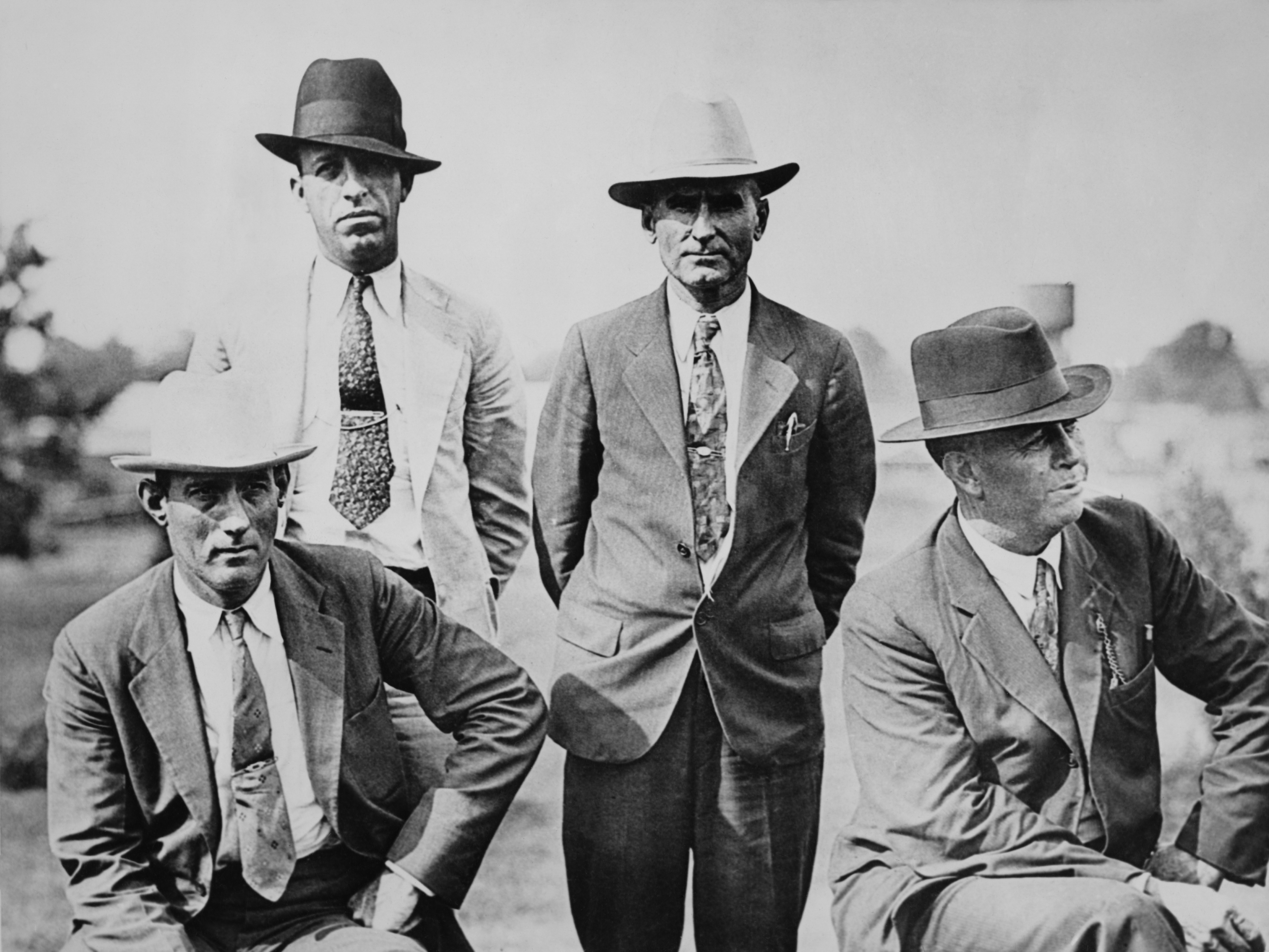
From left: Dallas County sheriff’s deputies Bob Alcorn and Ted Hinton and former Texas Rangers Maney Gault and Capt. Frank Hamer. Photography: FPG/Hulton Archive/Getty Images
C&I: Historically, Gault is a lesser-known figure than his partner, Frank Hamer, often cited as the most famous Texas Ranger ever. In taking on Maney Gault, did you get a clearer sense of who the real guy was?
Harrelson: Not really. Because, like you said, there really ain’t much out there on Gault like there is on Hamer. What I’d say I got was a clearer sense of who my imagination led me to think he was.
C&I: Who did you think he was?
Harrelson: Someone who wants to do the right thing but who’s also very much torn about the fact that he’s gonna be drawing on a woman, something he’s never done before. And just the fact that they’re kids, and I think he has a real conscience about that. On the other hand, he’s also very loyal to Frank. Plus, it also comes at a time when he really needs a job. Now, I don’t know how closely all of that follows the real Maney. It would’ve been nice to know more about the actual guy.
C&I: Why do you think the real Hamer and Gault signed up for this? Came out of retirement for it. Was it more than just pure duty?
Harrelson: Well, Hamer was in first. The governor wanted him. And he was just an I’ll-handle-this kinda guy. So I think he just knows he’s gonna do it because that’s what he does. Takes care of business. I think Maney just wants to hang with Frank. I don’t think he has the same great desire to take down these two, but of course in the end that’s exactly what he does.
C&I: You’ve played such a broad range of real-life figures, both famous — LBJ, Larry Flynt — and lesser-known. As an actor, is there an added weight or sense of responsibility when you’re entrusted with taking on the role of a real person and humanizing them on the screen?
Harrelson: Yeah, I definitely feel the weight of that. Especially in the case of someone who’s still alive, like Larry Flynt. Or with a former American president. But I felt that responsibility with Maney too. A lot of attention went into all those historical details, mainly from the pictures we have of him. What he would’ve worn. How he would’ve stood. Whatever we could know or gather about him.
C&I: You’d mentioned Paul Newman was originally attached to play Gault alongside Robert Redford. Now it’s you and Kevin Costner. Did that impact you at all, taking the baton from a legend like Paul Newman? Were you a fan?
Harrelson: Huge fan. He was one of my favorite actors. And, I mean, my God, that would’ve been quite a performance. I do like picturing him in the role, but also tried not to think about it too much. [Chuckles.]
C&I: Care to talk about your partner in the movie? What did Kevin Costner bring to the larger-than-life role of Frank Hamer?
Harrelson: Just incredible dedication. This was my first time working with him, and he really was as amazing as I’d expected. I remember early on when we were discussing the project, he said, “Y’know, I think about Frank and this movie and the story about 15 and a half hours a day.” And I remember thinking at the time — well, there’s a bit of an exaggeration. But then, when we were making the movie, I realized that he wasn’t kidding. He really was thinking about it every waking moment. He is just such a hard worker and cares so much — and obviously has always loomed large and done so many great parts and directed so many good movies. So it was a pleasure to get to work with him on this. He’s a first-rate actor.
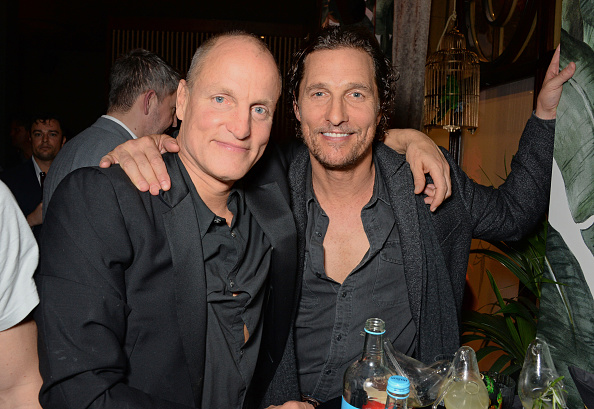
Photography: David M. Benett/Getty Image
C&I: A word about Texas. You’re from Texas. So’s director John Lee Hancock. So were Hamer and Gault. And Bonnie and Clyde. And so is Cowboys & Indians magazine. Is this all some crazy coincidence?
Harrelson: [Laughs.] Well, maybe or maybe not. But I think we can all agree that it’s a very unique state. I love Texas. I haven’t lived there in a very long time. Maybe it’ll happen again. I talk to my buddy [Matthew] McConaughey all the time, who lives outside of Austin, about how I’m gonna come back to Texas and move down the road from him — just so I can hound him. But a lot of great stuff has come out of Texas. It is definitely an original. People talk about it being like its own country. Certainly, some of the great people I’ve known have been from Texas, including the one I was just hanging out with till 6 in the morning last night, Willie Nelson.
C&I: Another famous Texan hiding out in Maui these days. And a close friend and neighbor, I understand?
Harrelson: Well, we’re not exactly neighbors. We don’t live too far away from each other. No one really does here. But he is one of my great buddies.
C&I: If you and Willie were out grabbing a beer somewhere in Maui, would people actually leave you guys alone?
Harrelson: You mean like at a bar? ... Well, we would definitely
run into a lot of people, but mostly locals who we already know. You’re also gonna meet some tourists here too, I guess.
C&I: Just to draw the scene of your own version of the Wild West from a phone call — is there a certain room, chair, lanai you like to take your morning C&I interviews from?
Harrelson: I still ain’t got outta bed, man. I’m just layin’ here in bed, head propped up, looking out at the best view imaginable.
C&I: Hate to ask a jealous question, but what are you seeing?
Harrelson: Well, we live about 4,000 feet up from the coast, so it’s just this epic view of the horizon and the ocean from my bedroom.
C&I: Enough said. When you’re not off on location or taking questions while recovering from a fun evening with Willie Nelson, what’s your version of a perfect day on the home front?
Harrelson: I’d say a day not unlike this one. I’ll probably have a smoothie for breakfast. I got a soccer game later. Maybe hit the water at some point. Hang out with friends and family. And just celebrate livin’ in such a fine place. I feel very lucky to be here.
C&I: How long have you been in Maui?
Harrelson: Twenty years.
C&I: No island fever symptoms?
Harrelson: Not yet. I don’t think I’ve ever been here so long that it’s ever happened. Definitely I’ve had the opposite, where I have to leave and I’m just brokenhearted over it.
C&I: Back to Hollywood. You crank out movie roles at what looks like a very brisk pace for a reputedly laid-back guy chilling in Hawaii. Some actors complain that there aren’t enough good roles out there. Are there too many for you?
Harrelson: [Laughs.] Well, that would be a brash statement. I think there’s a number of good roles, and I’m just really lucky to have the opportunity to play some of them. I guess if you look at IMDB or something, it seems like I’m just constantly working — and for awhile I was doing that — but I’m now really more in the mind-set of getting several months off in the year to spend with my family and live a little because I felt like I was just going from project to project. So I don’t wanna keep doing that. ... But on the other hand, y’know, there’s a lotta good things out there, a lot of cool movies.
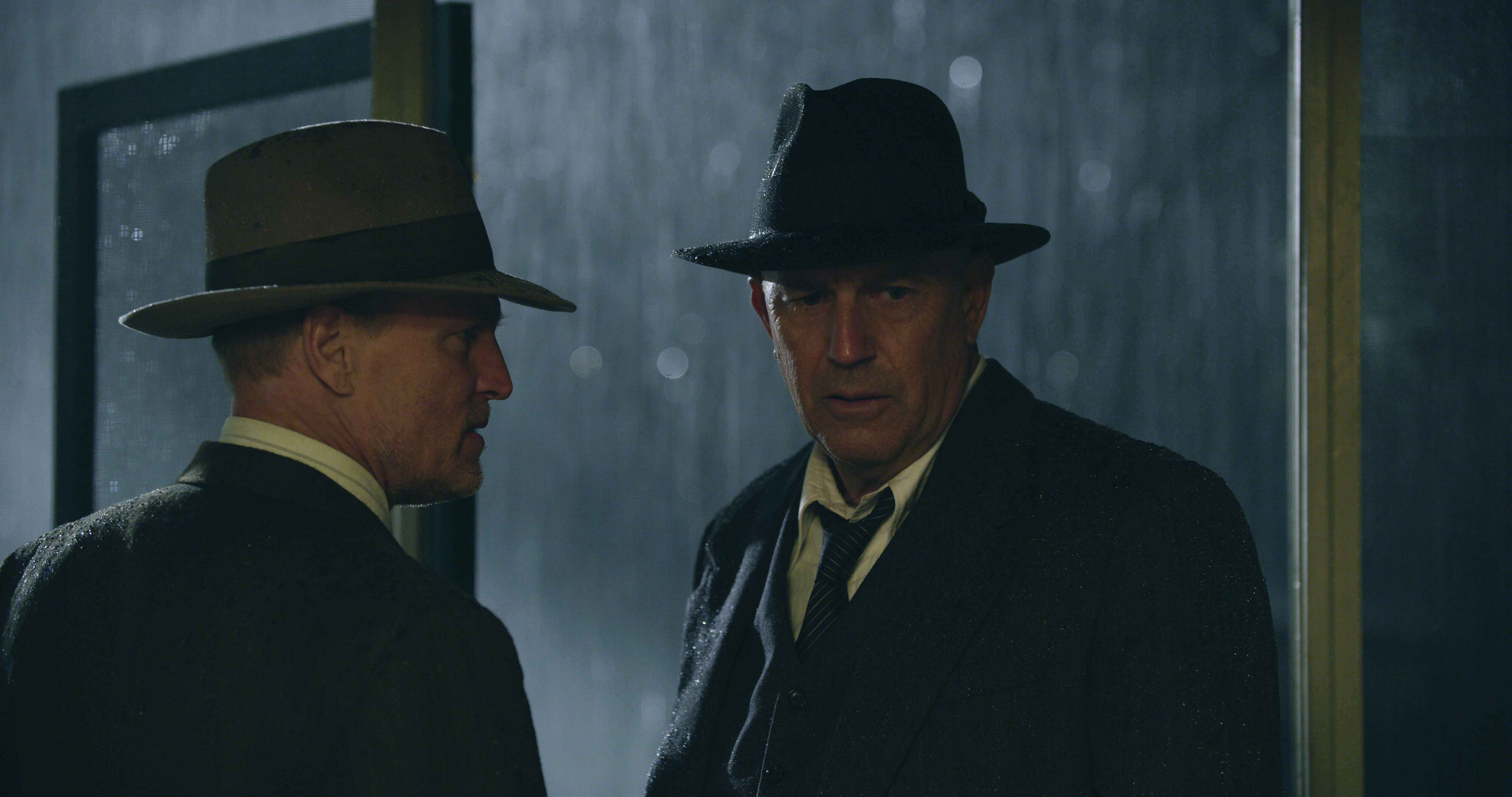
Photography: © 2019 Netflix/All Rights Reserved
C&I: Aside from the pace, there’s the range. You transition so easily between comedy, war drama, thriller, sci-fi, period western, environmental documentary – sometimes all in the same year or two. You wear a lot of hats, and they all fit. Behind the scenes, is it tougher than it looks to shift gears like that – between so many genres?
Harrelson: I don’t think so. I just try to take each project as it comes and focus on it and hopefully do it justice. I don’t know if I’ve always done that, but that’s always the goal.
C&I: Is there a genre in the mix that feels closest to home for you? And, leading question, would it be comedy?
Harrelson: Yeah, I definitely prefer comedy.
C&I: Is there a young Woody Boyd hiding somewhere in all your characters, except maybe LBJ?
Harrelson: [Laughs.] Maybe. I still love Woody Boyd. The sweetness of him. He’s in there somewhere. In fact, in many ways, that’s what’s inside of me.
C&I: Thirty years later, Woody on Cheers remains one of the most endearing sitcom characters ever. Is a role like that both a blessing and a potential typecasting trap? Looking back, how’d you escape it so thoroughly?
Harrelson: Well, yeah, I did feel that at the time. I was in it for several years without being able to get another job. Back then, it was harder to transition between TV and movies and whatever else. But after awhile I was really starting to worry that although, yeah, it’s a great part — would it be my only part? Luckily, Michael Caton-Jones cast me with Michael [ J.] Fox in Doc Hollywood, and then Ron Shelton cast me in White Men Can’t Jump, and that really shifted things and led to other parts.
C&I: What’s your version of the secret to longevity in Hollywood? If a young actor came up to you and asked for some solid advice, what would you tell them?
Harrelson: Well, I would probably quote [talent agent] Bryan Lourd, one of the heads of CAA. He would say to his agents, “Careers are made not by how many times you say yes, but how many times you say no.” Now anyone might look at what I’ve done lately and think, You’re not saying no to very much. [Laughs.] But I do feel like it’s important to not just do such-and-such because they’re gonna offer you the moon. It’s worth making sure that it’s a quality project. Again, I haven’t always adhered to that advice myself, but I try.
C&I: What attracts you to a role? What makes you say, “Yes!”?
Harrelson: Usually it’s a composite of things. I have to like the story as a whole, not just the role. Although there have been times I just took something more for the role, and I should have paid more attention to the whole. But ideally there needs to be a heart to both the piece and the character. That’s really important. Of course, who the director is, that’s right up there too. You might think to yourself at first, Well, that’s not such a great role. But wait. It’s Scorsese.
C&I: It’s been reported that as a kid growing up in Texas you dreamed about being a cop. Have Maney Gault and so many other roles — in True Detective, Three Billboards, the list goes on — safely fulfilled that dream?
Harrelson: Actually, it was more like Secret Service. When I was a little kid, I used to watch this show called The Wild Wild West about the first Secret Service agents fighting crime across the Old West, and I wanted to be that guy. Then I realized, Oh, wait. that guy is just an actor.
C&I: The silver lining: When you’re an actor, you can be anything.
Harrelson: You really can. Anything. That’s one of the great perks of this profession. You get to go out, meet people, learn about their professions, and then become them for a little while. Perpetual student — that ain’t such a bad dream job, too.
From the April 2019 issue.














